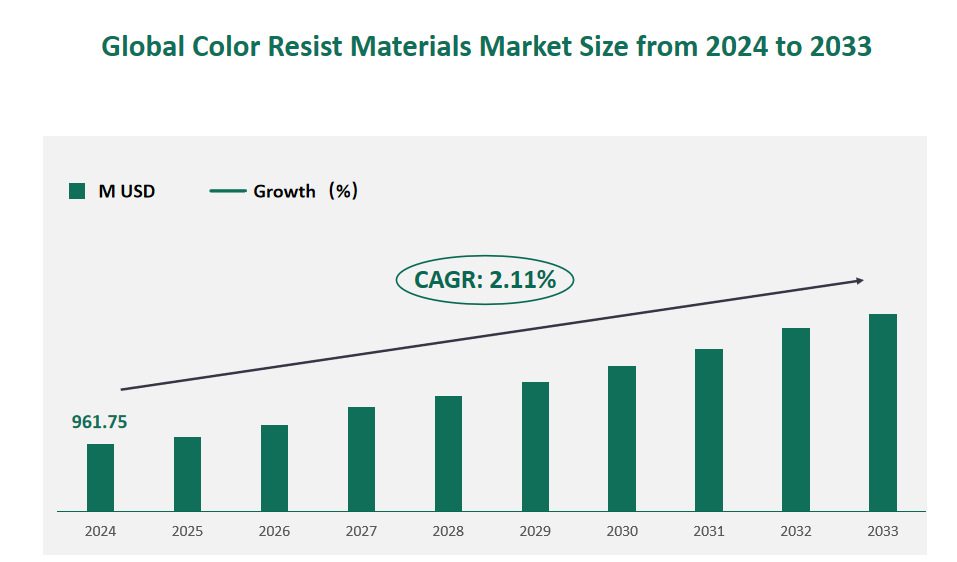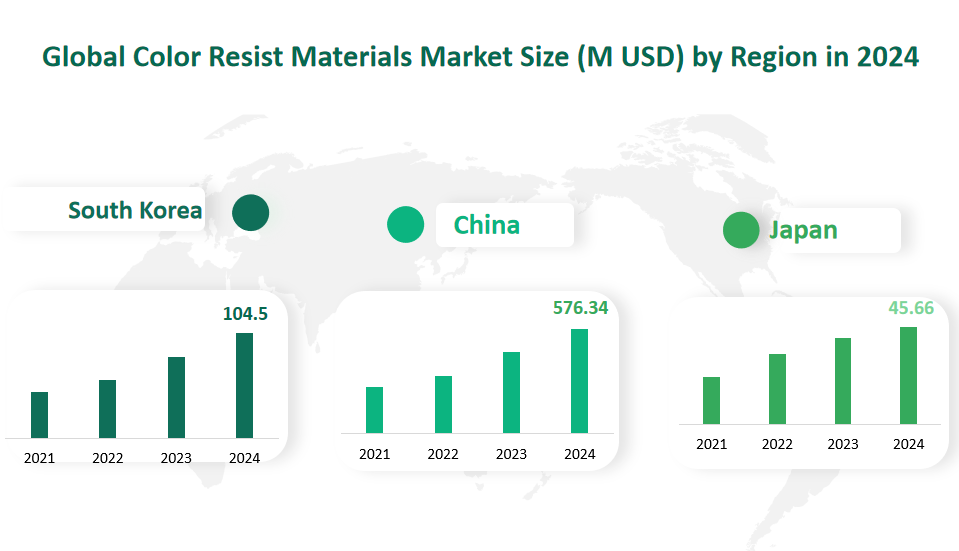1 Global Color Resist Materials Market Size (Value) and CAGR (2024-2033)
In 2024, the global Color Resist Materials market was valued at USD 961.75 million, with a CAGR of 2.11% from 2024 to 2033.
Color resist materials is a pigment-based ink for color filters. Color resist materials consists of coloring material (pigment or dye), polymer, photosensitive material and solvent. When the ink is exposed to ultraviolet rays, the exposed areas become insoluble and can resist the etching process. Adding these characteristics to ink is a key step in manufacturing color filters.
Figure Global Color Resist Materials Market Size (M USD) and CAGR 2024-2033

2 Color Resist Materials Market Drivers
The Color Resist Materials market is experiencing significant growth driven by several key factors and emerging opportunities. One of the primary drivers is the growing demand from key regions, particularly in Asia. Countries like China, South Korea, and Japan are at the forefront of electronics manufacturing, driving the need for high-quality color resist materials. China, in particular, is rapidly developing its domestic capabilities in LCD and OLED production, aiming to reduce its reliance on imported materials. This trend is expected to continue as more manufacturers in China and other emerging markets expand their production capacities.
Another significant driver is the increasing demand from downstream industries. The electronics industry, especially the segments related to TVs, monitors, notebooks, tablets, and mobile phones, is a major consumer of color resist materials. As these industries continue to grow and innovate, the demand for high-performance color filters is also on the rise. For instance, the push for higher resolution displays, wider color gamuts, and more energy-efficient screens is driving manufacturers to invest in advanced color resist materials that can meet these requirements.
Moreover, technological advancements in display technologies are creating new opportunities for the color resist materials market. The development of OLED displays, which offer superior image quality and flexibility compared to traditional LCDs, is a notable trend. OLED displays require specialized color resist materials that can provide better color reproduction and durability. As OLED technology becomes more mainstream, the demand for these materials is expected to increase significantly.
3 Color Resist Materials Market Restraints
Despite the growth opportunities, the Color Resist Materials market faces several challenges and restraints that could hinder its expansion. One of the primary challenges is the high technical barriers associated with the production of these materials. Color resist materials are highly specialized products that require a deep understanding of chemistry, materials science, and electronics. The manufacturing process involves precise formulation and control, and any deviation can result in substandard products. This complexity creates a high entry barrier for new players, limiting market competition and potentially leading to monopolistic practices by a few dominant companies.
Another significant restraint is the environmental regulations governing the production and use of electronic materials. Governments around the world are increasingly focusing on reducing the environmental impact of electronic manufacturing. This has led to stricter regulations on the use of certain chemicals and materials, including some components used in color resist materials. Manufacturers are required to invest in advanced technologies and processes to ensure compliance with these regulations, which can be costly and time-consuming.
The dependence on raw material suppliers is another challenge. The availability and price fluctuations of key raw materials, such as photo initiators and resins, can significantly impact the production costs and supply chain stability. Any disruption in the supply of these materials can lead to production delays and increased costs, affecting the overall market dynamics.
4 Global Color Resist Materials Market Size and Share by Type in 2024
In 2024, the total market value of Color Resist Materials reached 961.75 million USD. The segmentation by type reveals the following market sizes: Color Resist Materials for LCD accounted for 844.31 million USD, representing approximately 87.79% of the total market value. This segment is the dominant player in the market, driven by the widespread use of LCD technology in various applications, including TVs, monitors, notebooks, tablets, and mobile phones.
On the other hand, Color Resist Materials for OLED had a market value of 117.45 million USD in 2024, constituting 12.21% of the total market value. OLED technology represents a more advanced and rapidly growing segment within the display industry. OLED displays offer superior image quality, flexibility, and energy efficiency compared to traditional LCDs. Color resist materials for OLEDs are engineered to meet the unique requirements of this technology, such as higher luminance, broader color gamut, and better durability.
Table Global Color Resist Materials Market Size and Share by Type in 2024
Type | Market Size (M USD) 2024 | Market Share 2024 |
Color Resist Materials for LCD | 844.31 | 87.79% |
Color Resist Materials for OLED | 117.45 | 12.21% |
5 Global Color Resist Materials Market Sales and Share by Application in 2024
TVs accounted for the largest share of the market, with 12,002 tons sold in 2024, representing approximately 48.13% of the total sales. This significant share is attributed to the continuous demand for high-quality displays in televisions, driven by the increasing popularity of large-screen TVs and the need for high-resolution displays. Monitors followed with 6,373 tons, representing 25.56% of the total sales. The demand for monitors is driven by the growing need for high-performance displays in both consumer and professional settings, such as gaming and graphic design.
Notebooks and tablets accounted for 3,810 tons, or 15.28% of the total sales. The increasing use of portable devices for both personal and professional purposes has driven the demand for color resist materials in this segment. Mobile phones, although a smaller segment, accounted for 1,938 tons, or 7.77% of the total sales. The rapid advancement in mobile technology and the need for high-quality displays in smartphones have contributed to this demand. Lastly, other applications, such as automotive displays and industrial screens, accounted for 812 tons, or 3.25% of the total sales.
Table Global Color Resist Materials Market Sales and Share by Application in 2024
Application | Market Sales (Tons) 2024 | Market Share 2024 |
TVs | 12002 | 48.13% |
Monitors | 6373 | 25.56% |
Notebook and Tablet | 3810 | 15.28% |
| 1938 | 7.77% |
Others | 812 | 3.25% |
6 Global Color Resist Materials Market Size by Region in 2024
China emerged as the largest market, with a revenue of 576.34 M USD in 2024, representing approximately 59.93% of the total market. The rapid growth of the electronics industry in China, coupled with government initiatives to promote domestic production, has led to a significant increase in the demand for color resist materials. South Korea, known for its advanced electronics manufacturing capabilities, accounted for 104.50 M USD, or 10.87% of the total market. The presence of major electronics manufacturers and a focus on high-end display technologies have driven the demand in this region.
Taiwan, another key player in the electronics industry, accounted for 217.98 M USD, or 22.67% of the total market. The region’s strength in semiconductor and display manufacturing has contributed to its significant market share. Japan, with its expertise in advanced materials and electronics, accounted for 45.66 M USD, or 4.75% of the total market. The country’s focus on innovation and quality has maintained its position as a key supplier of color resist materials.
Figure Global Color Resist Materials Market Size by Region in 2024

7 Major Players in Global Color Resist Materials Market
7.1 Sumitomo Chemical
Company Profile: Sumitomo Chemical is a leading Japanese chemical company with a diverse range of products and services. Established in 1913, the company has a strong presence in various sectors, including petrochemicals, plastics, IT-related materials, health and crop sciences, and pharmaceuticals. Sumitomo Chemical’s manufacturing facilities are primarily located in Japan, and it operates globally, serving customers worldwide.
Business Overview: Sumitomo Chemical’s business sectors are diverse, covering a wide range of industries. In the Color Resist Materials segment, the company is known for its high-quality products and innovative solutions. Sumitomo Chemical’s DyBright is a world-leading product that offers dramatic high luminance and high color reproducibility, making it ideal for applications in home appliances, electronics, and display materials.
Product/Service Offered: Sumitomo Chemical offers a variety of color resist materials, including those used in LCD and OLED displays. These materials are designed to meet the stringent requirements of the electronics industry, ensuring high performance and reliability. The company’s products are used in various applications, including TVs, PCs, and other electronic devices.
Recent Financial Performance: In the most recent year, Sumitomo Chemical’s Color Resist Materials business reported a revenue of 271.97 million USD.
7.2 Jiangsu Yoke Technology
Company Profile: Jiangsu Yoke Technology Co., Ltd. is a prominent player in the electronics industry, specializing in the research and development of electronic semiconductor materials, cryogenic composite insulation materials, and plastic additives. Established in 1997, the company has grown to become a key supplier of color resist materials, particularly in the LCD and OLED display sectors. Jiangsu Yoke Technology’s manufacturing facilities are primarily located in China, and it serves a global customer base.
Business Overview: Jiangsu Yoke Technology is active in various segments of the electronics industry, including integrated circuits, wafer manufacturing, packaging, and flat panel displays. The company’s focus on innovation and quality has enabled it to develop advanced color resist materials that meet the needs of modern display technologies. In 2020, Jiangsu Yoke Technology’s subsidiary acquired color photoresist assets from LG Chem, further strengthening its position in the market.
Product/Service Offered: Jiangsu Yoke Technology offers a range of color resist materials designed for high-performance displays. These materials are used in various applications, including LCD and OLED displays, ensuring vibrant and accurate color reproduction. The company’s products are known for their high quality and reliability, making them a preferred choice for many electronics manufacturers.
Recent Financial Performance: In the most recent year, Jiangsu Yoke Technology reported a revenue of 191.82 million USD.
7.3 JSR
Company Profile: JSR Corporation is a leading Japanese company specializing in the development and supply of advanced materials for the electronics industry. Established in 1957, JSR has a strong presence in various sectors, including lithography materials, chemical mechanical planarization (CMP) materials, and packaging materials. The company’s manufacturing facilities are primarily located in Japan, and it operates globally, serving customers in the semiconductor and display industries.
Business Overview: JSR is known for its innovative solutions and advanced technologies, which have enabled it to become a key supplier of color resist materials. The company’s OPTMER CR Series, a pigment-dispersed negative-tone photoresist, is widely used in the formation of color filter layers for LCD displays. JSR’s focus on R&D and continuous improvement has allowed it to stay at the forefront of technological advancements in the industry.
Product/Service Offered: JSR offers a variety of color resist materials, including those used in LCD and OLED displays. These materials are designed to meet the stringent requirements of the electronics industry, ensuring high performance and reliability. The company’s products are used in various applications, including TVs, monitors, notebooks, tablets, and mobile phones.
Recent Financial Performance: In the most recent year, JSR reported a revenue of 86.68 million USD.

